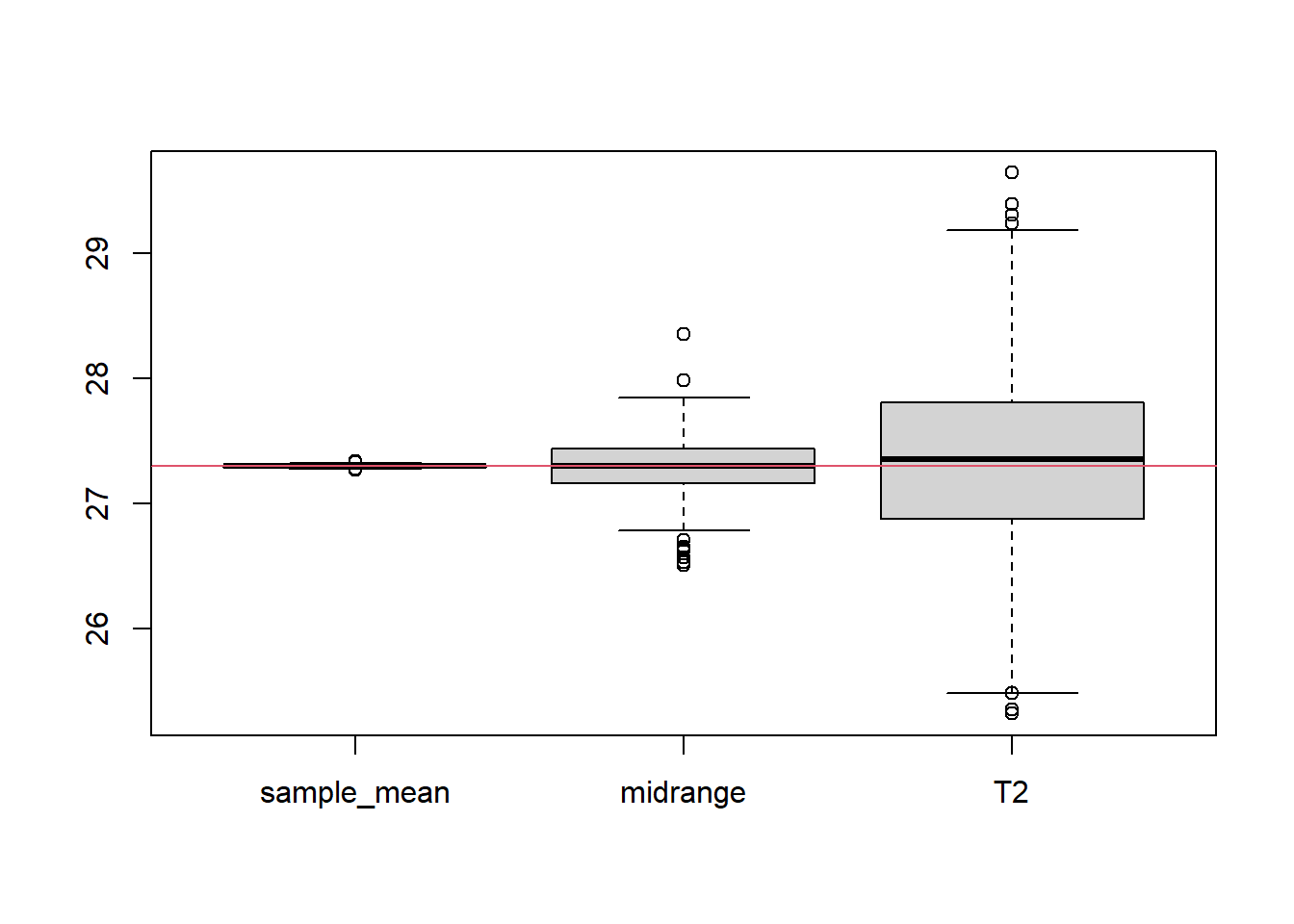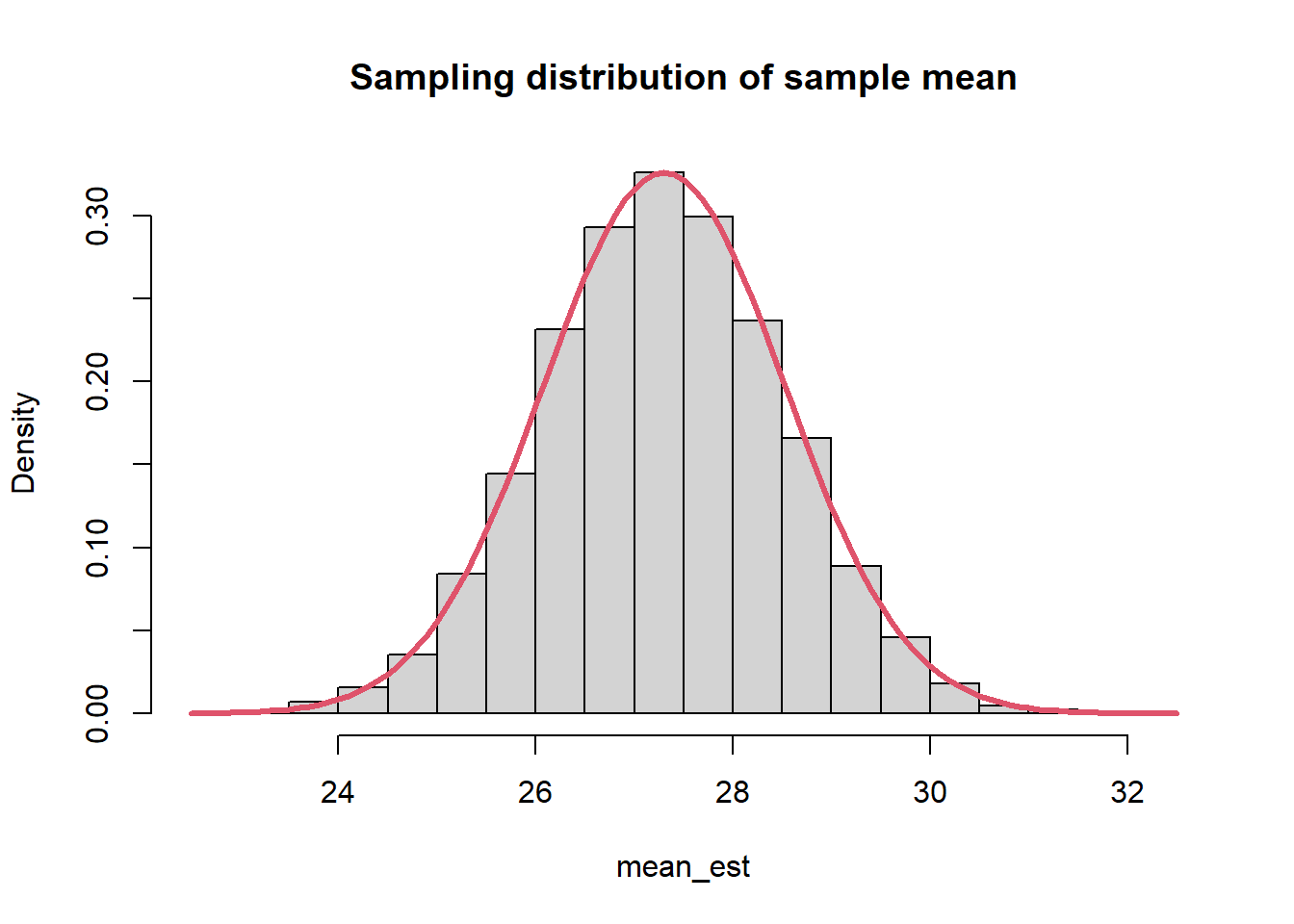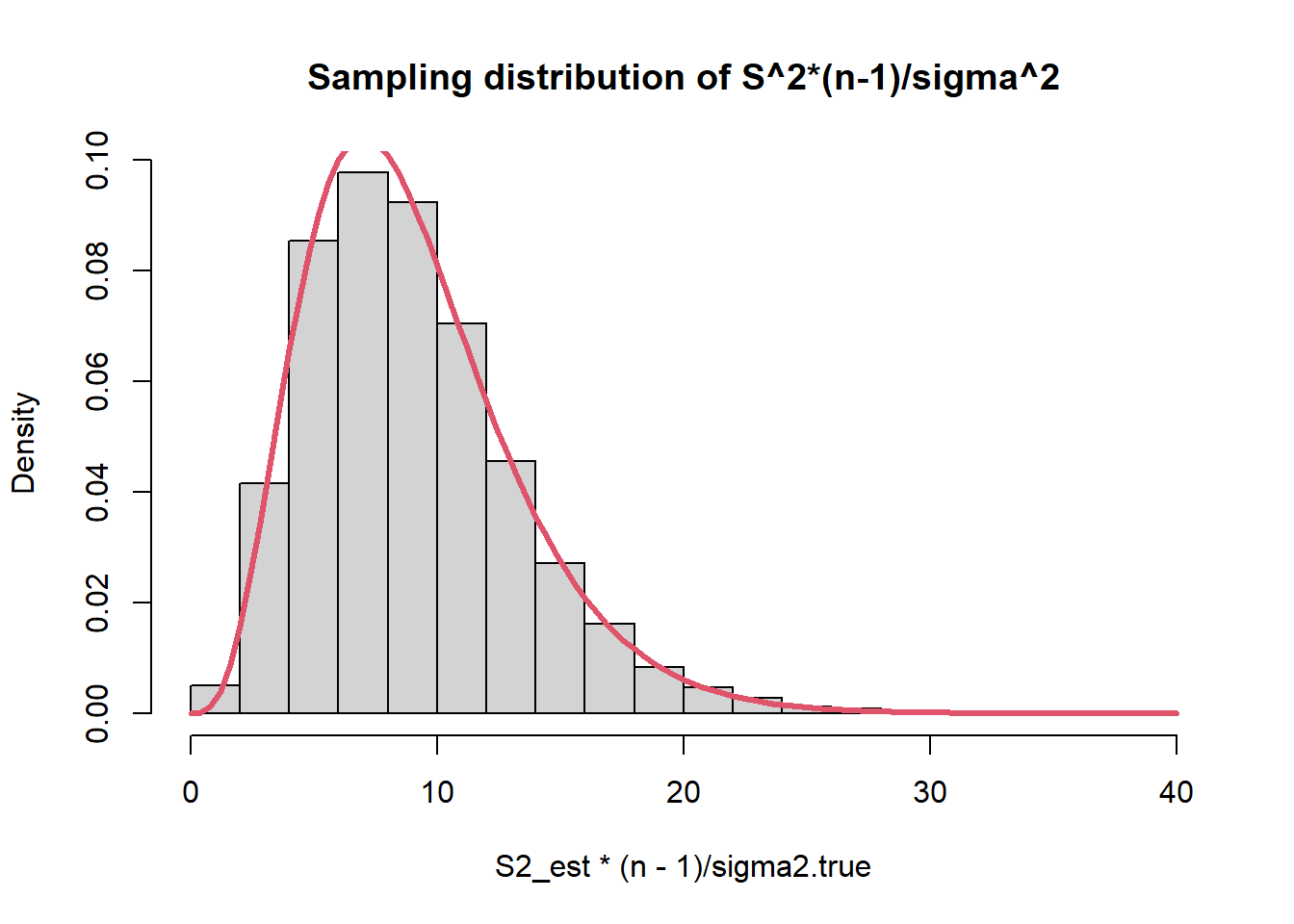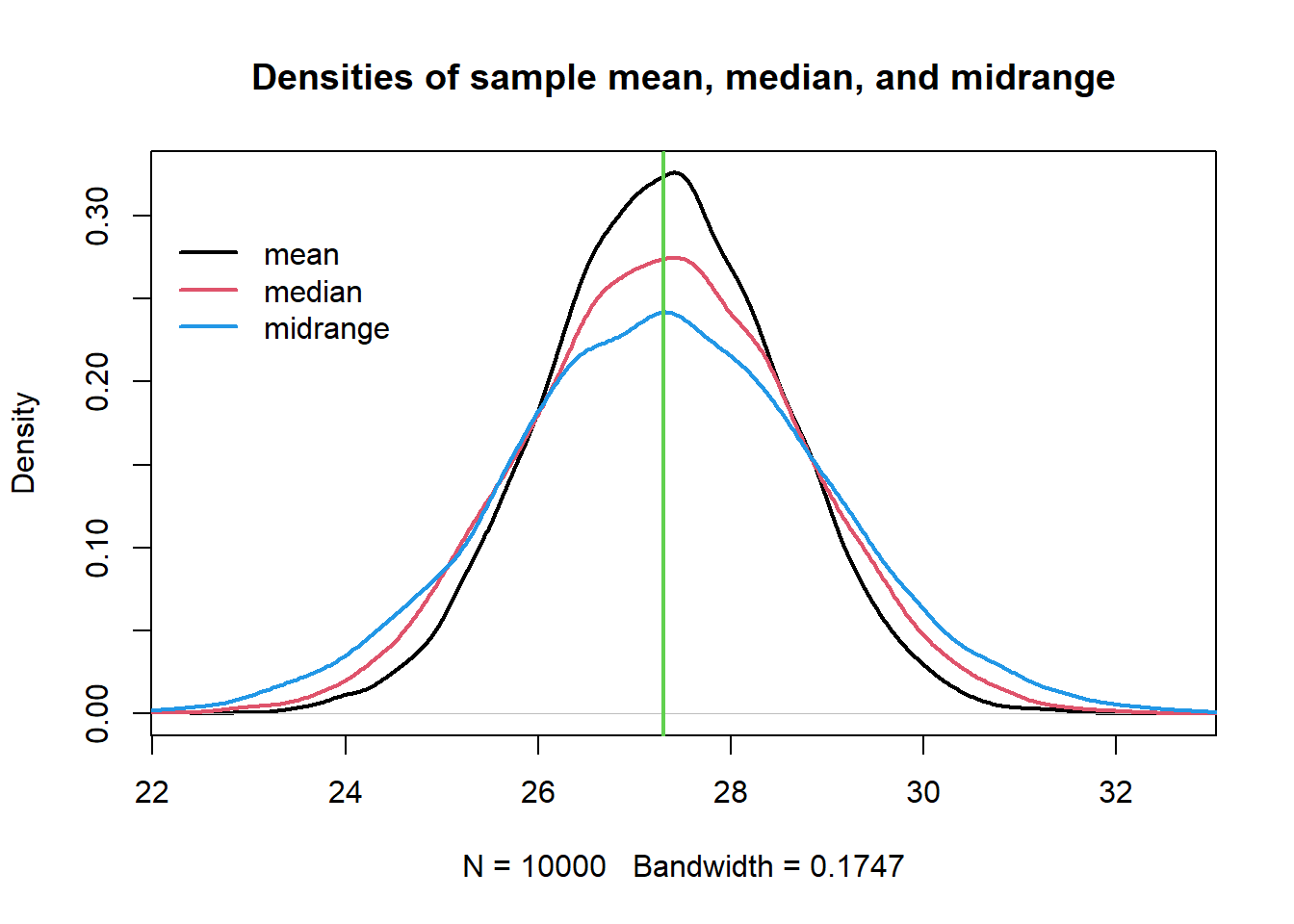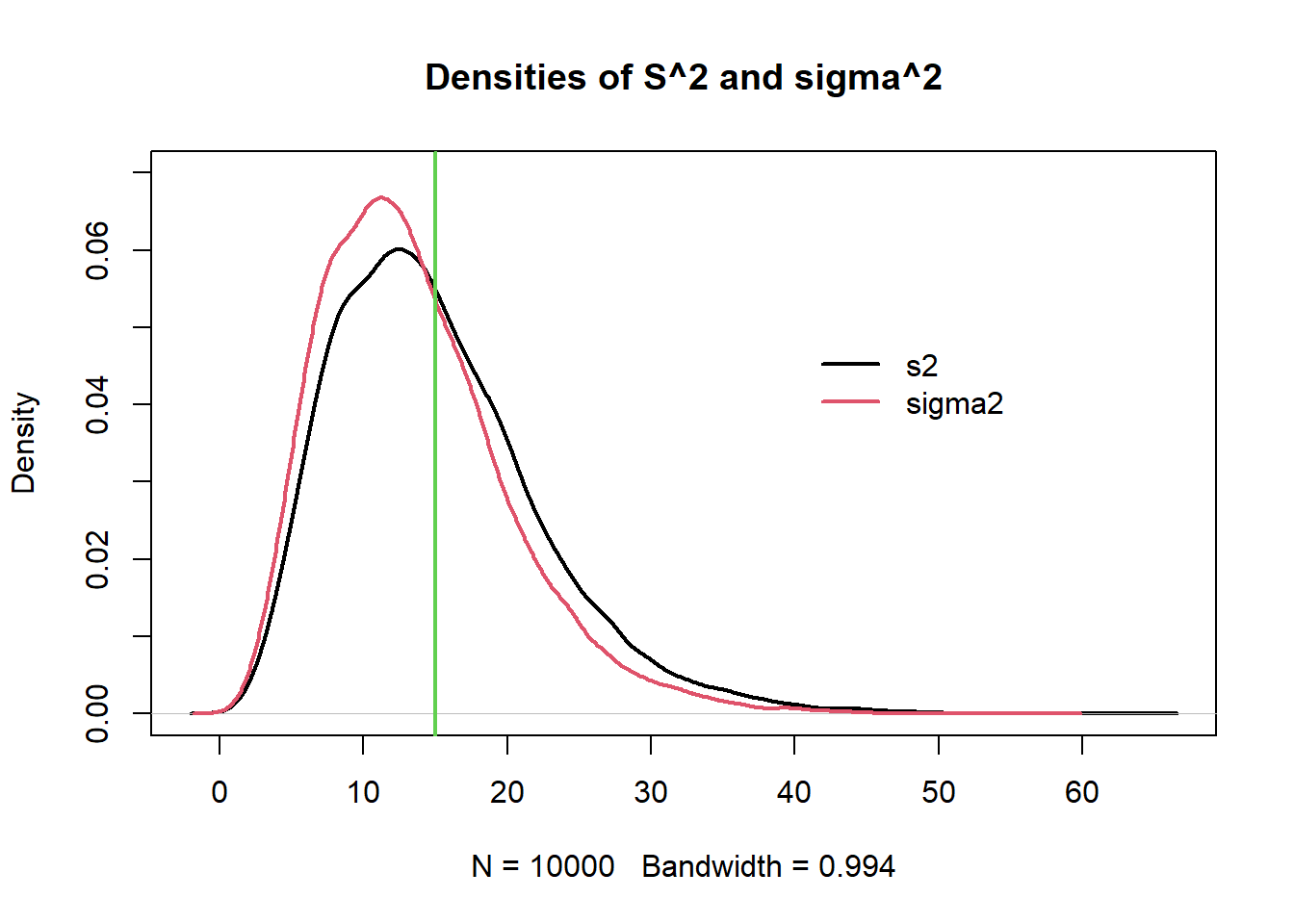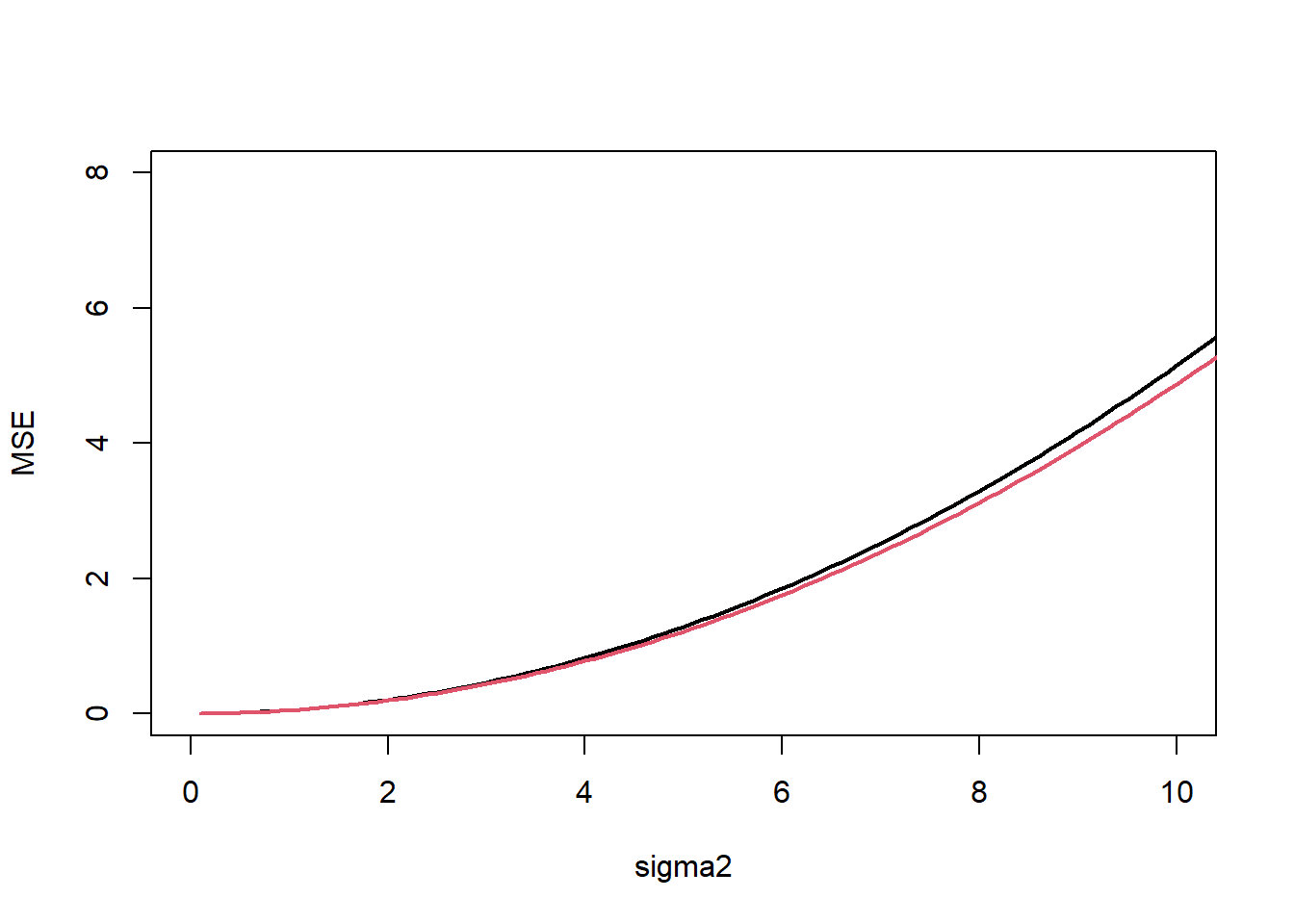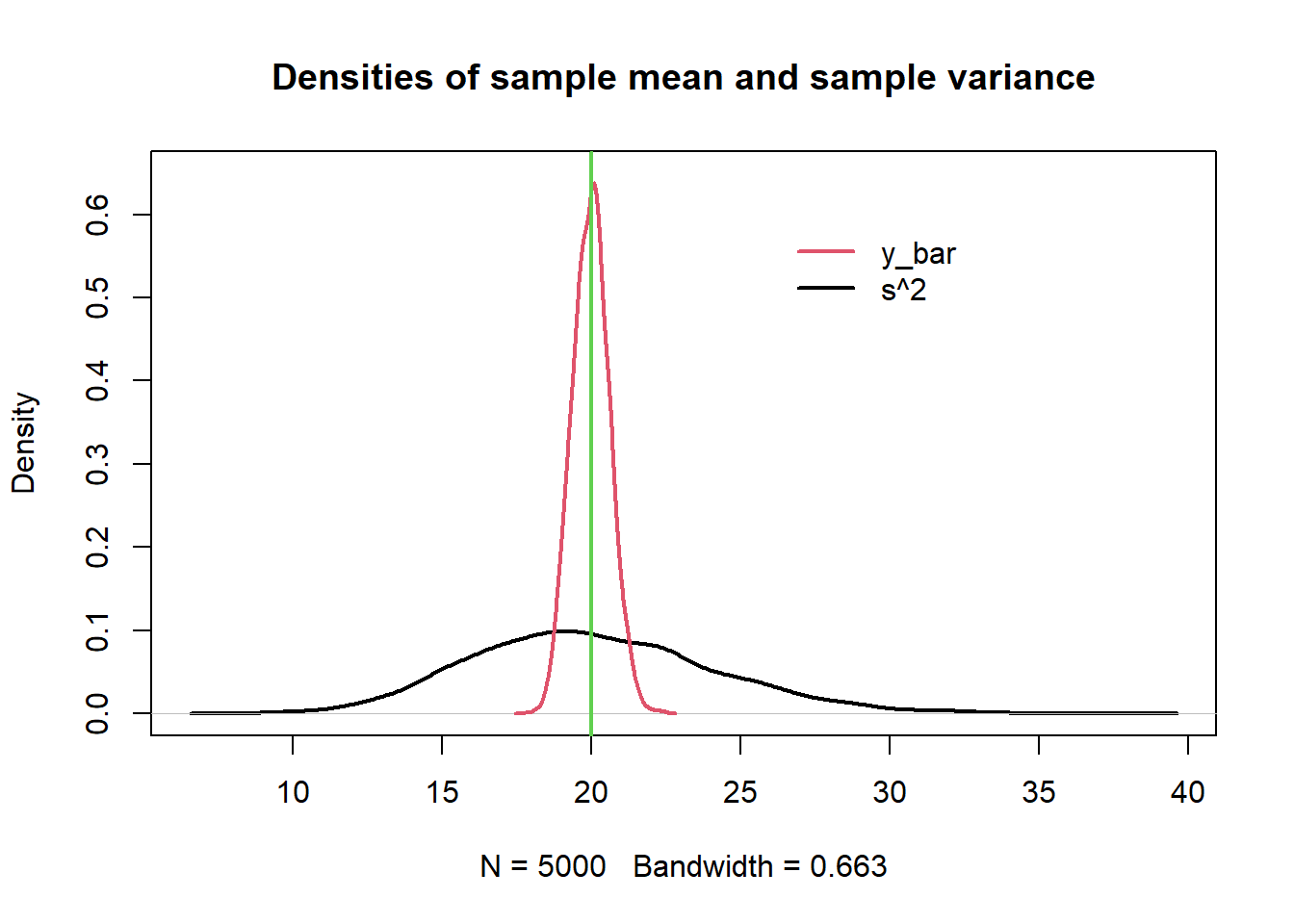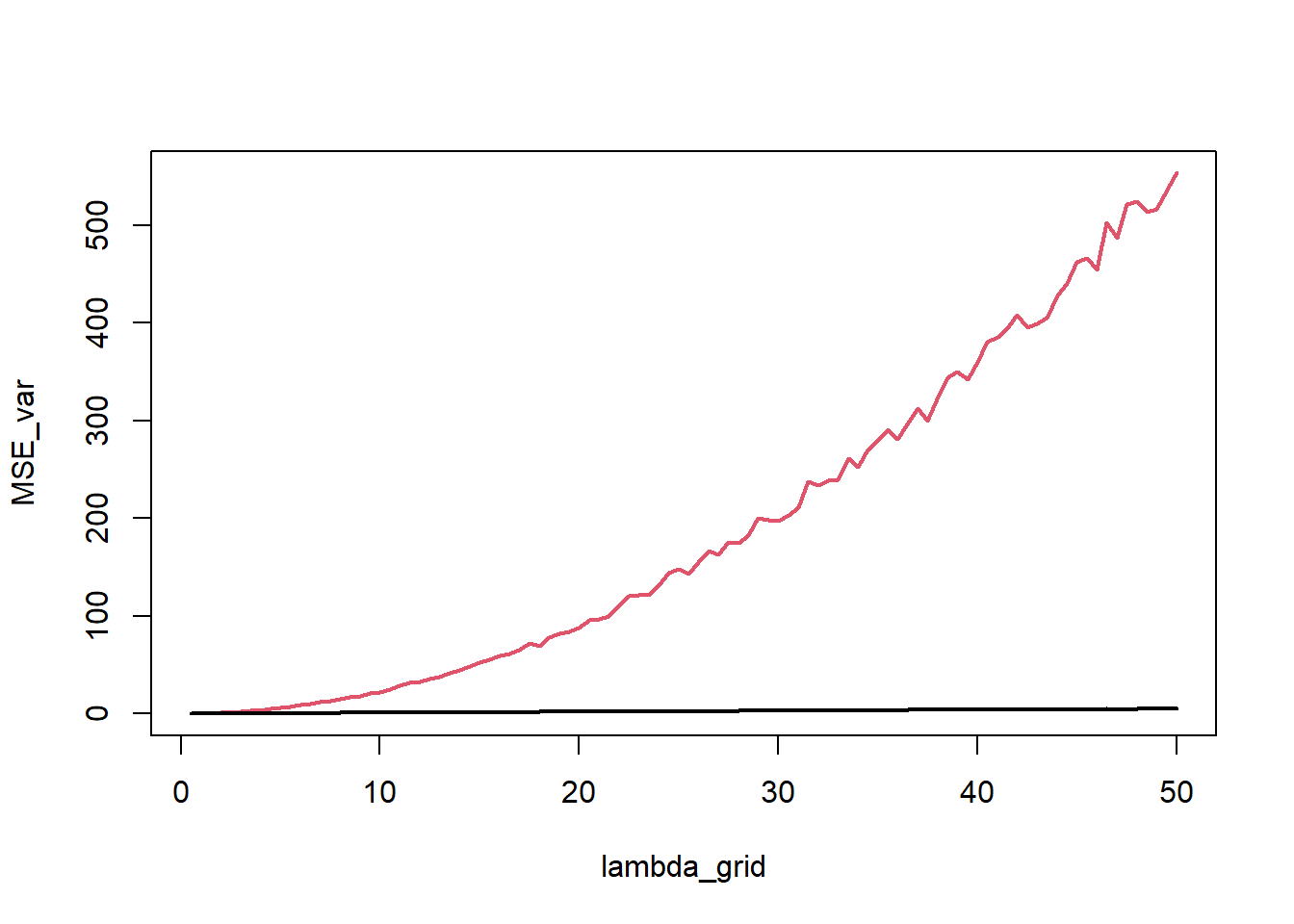<- 27.3 <- 1 <- c (10 , 25 , 50 , 100 , 200 ,500 , 1000 ,1250 , 1500 , 1750 , 2000 )<- length (sample_sizes)<- 50 <- matrix (NA , nrow= B, ncol= N_samples)<- matrix (NA , nrow= B, ncol= N_samples)<- matrix (NA , nrow= B, ncol= N_samples)set.seed (6 )for (i in 1 : B){for (j in 1 : N_samples){<- sample_sizes[i]<- rnorm (n, mean= mu.true, sd= sqrt (sigma2.true))<- mean (y)<- (min (y) + max (y))/ 2 <- (y[1 ] + y[n])/ 2 par (mfrow= c (1 ,3 ))plot (sample_sizes, mean_est[,1 ], type= "l" , ylim= c (26 ,28 ), main = "Sample Means" , ylab = "Estimate" , xlab = "n" )for (i in 2 : N_samples){points (sample_sizes, mean_est[,i], type= "l" )abline (h= mu.true, col= "red" , lwd= 2 )################################################ plot (sample_sizes, T_range[,1 ], type= "l" , ylim= c (26 ,28 ), main = "Mid range" , ylab = "Estimate" , xlab = "n" )for (i in 2 : N_samples){points (sample_sizes, T_range[,i], type= "l" )abline (h= mu.true, col= "red" , lwd= 2 )################################################ plot (sample_sizes, T_2[,1 ], type= "l" , ylim= c (26 ,28 ), main = "T2" , ylab = "Estimate" , xlab = "n" )for (i in 2 : N_samples){points (sample_sizes, T_2[,i], type= "l" )abline (h= mu.true, col= "red" ,lwd= 2 )
par (mfrow= c (1 ,1 ))# Let's replicate the estimation procedure for n=10000 <- 1000 <- numeric (B)<- numeric (B)<- numeric (B)for (i in 1 : B){<- rnorm (10000 , mean= mu.true, sd= sqrt (sigma2.true))<- mean (y)<- (min (y) + max (y))/ 2 <- (y[1 ] + y[10000 ])/ 2 boxplot (cbind (sample_mean= mean_est,midrange= T_range,T2= T_2))abline (h= mu.true, col= 2 )
############################################## ######## 1.2 - Comparing estimators: ######### ############################################## <- 27.3 <- 15 <- 10 # Sampling distributions: <- 10000 <- numeric (B)<- numeric (B)<- numeric (B)<- numeric (B)<- numeric (B)set.seed (6 )for (b in 1 : B){<- rnorm (n, mean= mu.true, sd= sqrt (sigma2.true))<- mean (y)<- median (y)<- (min (y) + max (y))/ 2 <- var (y)<- var (y)* (n-1 )/ nhist (mean_est, prob= T, main= "Sampling distribution of sample mean" )curve (dnorm (x, mu.true, sd= sqrt (sigma2.true/ n)), col= 2 , lwd= 3 ,add= T)hist (S2_est, prob= T, main= "Sampling distribution of S^2" )curve (dchisq (x, n-1 ), col= 2 , add= T, lwd= 3 )hist (S2_est* (n-1 )/ sigma2.true, prob= T, main= "Sampling distribution of S^2*(n-1)/sigma^2" )curve (dchisq (x, n-1 ), col= 2 , add= T, lwd= 3 )# Expected values (approximated): mean (mean_est)# Biases (approximated): mean (mean_est) - mu.truemean (median_est) - mu.truemean (S2_est) - sigma2.truemean (sigma2_est) - sigma2.true# MSEs (approximated): mean ((mean_est - mu.true)^ 2 )mean ((median_est - mu.true)^ 2 )mean ((T_range - mu.true)^ 2 )mean ((S2_est - sigma2.true)^ 2 )mean ((sigma2_est- sigma2.true)^ 2 )# Bias-variance trade-off (it holds for B >> 0, it is approximated): mean ((mean_est - mu.true)^ 2 )mean (mean_est) - mu.true)^ 2 + var (mean_est)* (B-1 )/ B# Other measures: # MAEs (approximated): mean (abs (mean_est - mu.true))mean (abs (median_est - mu.true))mean (abs (T_range - mu.true))mean (abs (S2_est - sigma2.true))mean (abs (sigma2_est- sigma2.true))# ARB Absolute relative bias (approximated): mean (abs (mean_est - mu.true)/ mu.true)mean (abs (median_est - mu.true)/ mu.true)mean (abs (T_range - mu.true)/ mu.true)mean (abs (S2_est - sigma2.true)/ sigma2.true)mean (abs (sigma2_est- sigma2.true)/ sigma2.true)# Sampling Distributions: plot (density (mean_est), main= "Densities of sample mean, median, and midrange" , lwd= 2 )lines (density (median_est), col= 2 , lwd= 2 )lines (density (T_range), col= 4 , lwd= 2 )abline (v= mu.true, col= 3 , lwd= 2 )legend (22 ,.3 , legend= c ("mean" , "median" , "midrange" ), col= c (1 : 2 ,4 ), lty= 1 , lwd= 2 , bty = "n" )plot (density (S2_est), main= "Densities of S^2 and sigma^2" , ylim= c (0 ,0.07 ), lwd= 2 )lines (density (sigma2_est), col= 2 , lwd= 2 )abline (v= sigma2.true, col= 3 , lwd= 2 )legend (40 ,.05 , legend= c ("s2" , "sigma2" ), col= 1 : 2 , lty= 1 , bty = "n" , lwd= 2 )##################################################### ##### 1.3 - Comparing estimators for variance: ###### ##################################################### # This function returns the MSE of S^2 and sigma2_hat # approximated with B replicates <- function (mu, sigma2, n, B){<- numeric (B)<- numeric (B)set.seed (42 )for (b in 1 : B){<- rnorm (n, mu, sqrt (sigma2))<- var (y)<- ((n-1 )/ n)* var (y)<- mean ((est_s2- sigma2)^ 2 )<- mean ((est_sigma2- sigma2)^ 2 )return (c (mse_s2, mse_sigma2))mse_normal_sigma2 (mu= 10 , sigma2= 15 , n= 10 , B= 50 )# Grid of values for (the true) sigma2 <- seq (0.1 , 50 , by= 0.1 )<- 1000 <- numeric (length (sigma2_vector))<- numeric (length (sigma2_vector))for (s in 1 : length (sigma2_vector)){<- mse_normal_sigma2 (10 , sigma2_vector[s], 40 , B)<- mse[1 ]<- mse[2 ]plot (sigma2_vector, mse_s2, pch= 20 ,type= "l" , ylab= "MSE" , xlab= "sigma2" , lwd= 2 , xlim= c (0 ,10 ),ylim= c (0 ,8 ))points (sigma2_vector, mse_sigma2, pch= 20 , type= "l" , col= 2 , lwd= 2 )legend (0 ,150 , legend= c ("S2" , "sigma2_hat" ), col= c (1 ,2 ), lty= 1 , bty= "n" , lwd= 2 )################################################ ##### 1.4 - Comparing estimators Poisson: ###### ################################################ <- 20 <- 50 <- 5000 <- numeric (B)<- numeric (B)set.seed (369 )for (b in 1 : B){<- rpois (n, lambda)<- mean (y)<- var (y)<- mean ((est_mean- lambda)^ 2 ); mse_mean<- mean ((est_s2- lambda)^ 2 ); mse_s2plot (density (est_s2), main= "Densities of sample mean and sample variance" ,ylim= c (0 ,.65 ), lwd= 2 )lines (density (est_mean), col= 2 , lwd= 2 )abline (v= lambda, col= 3 , lwd= 2 )legend (26 ,.6 , legend= c ("y_bar" , "s^2" ), col= 2 : 1 , lty= 1 , bty = "n" , lwd= 2 )<- 10 <- 5000 <- seq (0.5 , 50 , by= .5 )<- numeric (length (lambda_grid))<- numeric (length (lambda_grid))for (l in 1 : length (lambda_grid)){<- numeric (B)<- numeric (B)for (b in 1 : B){<- rpois (n, lambda= lambda_grid[l])<- mean (x)<- var (x)<- mean ((stime_media - lambda_grid[l])^ 2 )<- mean ((stime_var - lambda_grid[l])^ 2 )plot (lambda_grid, MSE_var, type= "l" , col= 2 , lwd= 2 )points (lambda_grid, MSE_mean, type= "l" , lwd= 2 )

